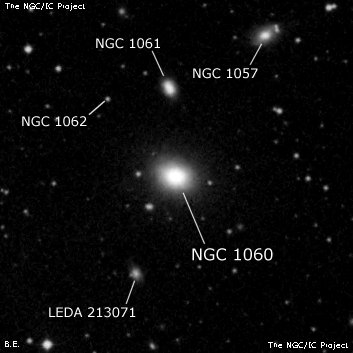
Huey (22" @230 and 383x): Very bright round glow with diffuse edges, 1.3' across. Gradually then suddenly brighter center.
William Herschel discovered NGC 1060 = H III-162 = h257, along with NGC 1066, on 12 Sep 1784 (sweep 268) and described the pair as "Two, both vF, pS, R lbM". WH's position is about 15 seconds of RA east and 3' north of UGC 2191 = PGC 10302. John Herschel made 3 observations and mentioned a "red *7.8 43.5 tsec preceding", though the star is east-southeast.
400/500mm - 17.5" (11/27/92): moderately bright, fairly small, round, halo gradually brightens to small bright core, stellar nucleus. Located 10' WNW of mag 7.7 SAO 55822. Brightest in a group with NGC 1061 2.5' N and NGC 1066 8' ENE.
600/800mm - 24" (9/23/17): at 260x; bright, large, nearly 2'x1.5', sharply concentrated with a large bright core that gradually increases to a stellar nucleus. A mag 15 star is at the east edge of the halo [1.0' from center]. Brightest in a group (reobserved due to a current supernova in NGC 1067).
24" (2/7/16): very bright, large, sharply concentrated with an intensely bright core that increases to the center. The much fainter halo gradually dims and is slightly elongated WSW-ENE, ~1.6'x1.3'. Brightest in a group of 10 galaxies (including 5 NGCs) in a 20' field.
The two closest galaxies are NGC 1061 2.5' N and PGC 213071 3' SSE ("extremely faint, small, roundish, 12"-15"). On the south side of the cluster is MCG +05-07-034 ("fairly faint, fairly small, round, 20" diameter, fairly low even surface brightness. Two mag 14.8/15.1 stars at 11" separation lie 1.7' SE. Located 9.6' S of NGC 1060). CGCG 505-042 is 4.9' further east-southeast. It was logged as moderately bright, fairly small, elongated 3:2 E-W, 21"x14", fairly high surface brighness. A mag 14.5 star is 1.5' E.
Notes by Steve Gottlieb